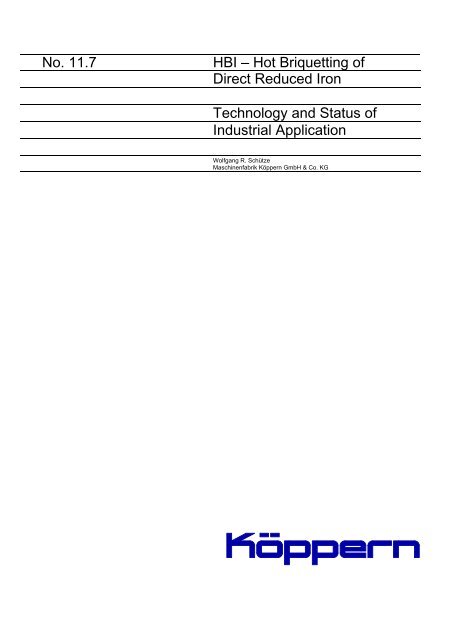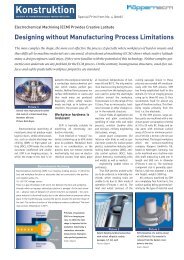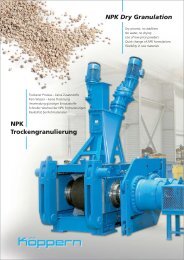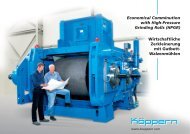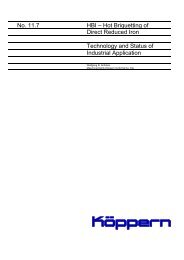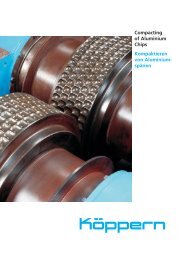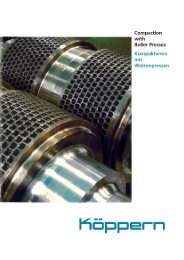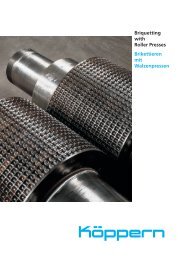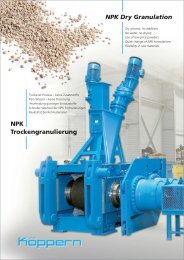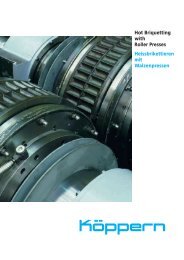Hot Briquetting of - Maschinenfabrik Köppern GmbH & Co. KG
Hot Briquetting of - Maschinenfabrik Köppern GmbH & Co. KG
Hot Briquetting of - Maschinenfabrik Köppern GmbH & Co. KG
Create successful ePaper yourself
Turn your PDF publications into a flip-book with our unique Google optimized e-Paper software.
No. 11.7 HBI – <strong>Hot</strong> <strong>Briquetting</strong> <strong>of</strong><br />
Direct Reduced Iron<br />
Technology and Status <strong>of</strong><br />
Industrial Application<br />
Wolfgang R. Schütze<br />
<strong>Maschinenfabrik</strong> <strong>Köppern</strong> <strong>GmbH</strong> & <strong>Co</strong>. <strong>KG</strong>
Resume.<br />
HBI – <strong>Hot</strong> <strong>Briquetting</strong> <strong>of</strong> Direct Reduced Iron<br />
Technology and Status <strong>of</strong> Industrial Applications<br />
by<br />
Dipl.-Ing. Wolfgang R. Schütze<br />
General Manager - <strong>Hot</strong> <strong>Briquetting</strong><br />
<strong>Maschinenfabrik</strong> KÖPPERN <strong>GmbH</strong> & <strong>Co</strong>. <strong>KG</strong><br />
Königsteiner Str. 2<br />
D-45529 Hattingen/Ruhr, GERMANY<br />
Tel.: (+49 2324) 207-0 Fax.: (+49 2324) 207-207<br />
<strong>Hot</strong> briquetting is a reliable, fully developed industrial concept for the passivation <strong>of</strong><br />
direct reduced iron produced with the various processes <strong>of</strong> direct reduction. Because,<br />
during hot briquetting, the large specific surface area <strong>of</strong> direct reduced iron is drastically<br />
reduced, the well known problems caused by reoxidation, overheating and hydrogen<br />
generation are avoided. Even the shipping instructions published by the International<br />
Maritime Organization (IMO) confirm that <strong>Hot</strong> Briquetted Iron (HBI) can be handled and<br />
shipped without special precautions.<br />
From the mid 1970s until today, after extensive pilot testing <strong>of</strong> the technology, a number<br />
<strong>of</strong> industrial plants for the hot briquetting <strong>of</strong> direct reduced iron went into operation. Additional<br />
hot briquetting plants for already established but also for new direct reduction<br />
processes are under construction or in different stages <strong>of</strong> planning.<br />
The paper describes the characteristics <strong>of</strong> HBI and its current industrial application for<br />
various Direct Reduction Processes.<br />
Introduction.<br />
Direct Reduced Iron has become a widely accepted source <strong>of</strong> premium iron units for<br />
steel making. Its advantages as a virgin iron product and diluent for impurities,<br />
introduced with scrap, are well documented.<br />
Direct Reduction plants produce different materials that are based on:<br />
• DRI (Direct Reduced Iron)<br />
or<br />
• HBI (<strong>Hot</strong> Briquetted Iron)<br />
Most <strong>of</strong> the early Direct Reduction Plants were built as part <strong>of</strong> integrated Mini Mills in<br />
which the DRI, after cooling, was fed to and consumed by electric arc furnaces in<br />
varying proportions <strong>of</strong> the total charge.<br />
1
Today, an increasing number <strong>of</strong> Merchant Direct Reduction Plants operates in several<br />
locations. Others are in different stages <strong>of</strong> planning and construction. In these facilities,<br />
premium, "alternative" iron units are produced for export to the world's steel industry.<br />
Because <strong>of</strong> its much better shipping and handling characteristics, HBI gains an<br />
increasing importance for the supply <strong>of</strong> international markets.<br />
In the following, the differences between the two types <strong>of</strong> products are discussed.<br />
<strong>Hot</strong> briquetted iron will be particularly reviewed with regard to:<br />
- Specific advantages and Characteristics <strong>of</strong> HBI<br />
- Equipment and plants for the production <strong>of</strong> HBI<br />
- HBI from different Direct Reduction Processes<br />
- Development <strong>of</strong> the industrial application <strong>of</strong> HBI<br />
HBI - Why?<br />
Fundamentals.<br />
During direct reduction, oxygen is removed from iron ore in solid state. This procedure<br />
results in a spongy structure <strong>of</strong> the product, thus "Sponge Iron", with a high porosity. Depending<br />
on the raw material and the reduction process applied, apparent product<br />
density is approx. 2 g/cm³ associated with a very high specific surface area. The latter is<br />
typically around 1 m²/g.<br />
Due to the large specific surface area, DRI reacts very easily with water (particularly sea<br />
water) and/or oxygen. Since the reaction is exothermic, heat is produced. Owing to its<br />
spongy structure, DRI is also an excellent insulator. Therefore, the excess heat produced<br />
in a DRI storage pile by, for example, the reoxidation with water does not easily<br />
dissipate. This can cause overheating and meltdown <strong>of</strong> DRI in piles, silos, or - most<br />
dangerously - ship holds. The reaction with water also produces Hydrogen which yields<br />
explosive mixtures with air.<br />
Since the beginning <strong>of</strong> Direct Reduction, methods for passivation <strong>of</strong> the product have<br />
been developed and tested. <strong>Hot</strong> briquetting has become the most reliable process for<br />
this task. By applying this technique, direct reduced iron is densified immediately after<br />
reduction at high temperatures and with very high pressures. Industrial facilities in<br />
connection with different Direct Reduction Technologies exist already for several years.<br />
Figure 1: <strong>Co</strong>mparison <strong>of</strong> the structure <strong>of</strong> DRI pellets (left) and HBI (right).<br />
2
<strong>Hot</strong> briquetting <strong>of</strong> DRI closes internal pores, lowers the accessible surface, increases<br />
the apparent density, and improves thermal conductivity, all <strong>of</strong> which reduce reactivity<br />
(Fig. 1). Reoxidation and overheating <strong>of</strong> HBI is very unlikely. This results in considerable<br />
improvements <strong>of</strong> storage and transport characteristics. Additional advantages, such as<br />
higher density, improved handling, uniform product shape and size, as well as reduced<br />
fines production, are results <strong>of</strong> the physical characteristics <strong>of</strong> the HBI.<br />
DRI from fine ores, reduced in fluid bed processes, is even more reactive and, even<br />
after cooling, cannot be safely handled in the open. In this case, hot briquetting not only<br />
passivates the product but also solves the inherent handling problems associated with<br />
the fine particulate material.<br />
The reoxidation behaviour <strong>of</strong> HBI was tested in a production plant (MIDREX process)<br />
with a 600 t briquette pile [3]. Inspite <strong>of</strong> a tropical climate and high salt content in the<br />
atmosphere (coastal location) no heating occured and after open storage for one month<br />
only 0.8 % metallization was lost. Prior to the first transport by sea, tests were carried<br />
out using simulated ship holds where HBI was wetted with sea water. Again, the stability<br />
<strong>of</strong> the product was demonstrated [6]. Other trials evaluated the heating <strong>of</strong> briquetted<br />
material in an oxidizing atmosphere simulating the preheating <strong>of</strong> scrap. No loss <strong>of</strong><br />
metallization was determined.<br />
The characteristics <strong>of</strong> HBI constitute important advantages as compared with the results<br />
<strong>of</strong> other passivation processes. For example the passivation effect <strong>of</strong> aging is much less<br />
pronounced and disappears in the presence <strong>of</strong> water, particularly seawater.<br />
For this reason, the advantages <strong>of</strong> HBI have become part <strong>of</strong> the IMO Shipping<br />
Regulation [4]. IMO distinguishes between DRI and "sponge iron which has been<br />
briquetted at temperatures <strong>of</strong> ≥ 650° C and has reached an apparent density <strong>of</strong> ≥ 5<br />
g/cm³ (HBI). For the latter, in addition to considerably simplified shipping requirements,<br />
"open storage prior to loading" is acceptable.<br />
As compared with DRI, the following punch list provides a summary <strong>of</strong> the most<br />
important specific characteristics <strong>of</strong> HBI:<br />
- No change in the chemical analysis by the briquetting process.<br />
- Only minimal loss <strong>of</strong> metallization even after long time storage.<br />
- Open air storage both at the producer and user sites does not cause problems<br />
(no need for inertized silos as with DRI).<br />
- Minimum risk <strong>of</strong> overheating during storage and transport (e.g. IMO allows "open<br />
storage prior to loading").<br />
- Special inertization <strong>of</strong> ship holds is not required (no specially equipped ships).<br />
- Little production <strong>of</strong> fines during handling.<br />
- Handling similar to scrap (open air storage, transport with front-end loaders, magnets,<br />
belts, redlers, etc.); an additional advantage is the relatively small and<br />
uniform product size (charging <strong>of</strong> furnaces).<br />
- High apparent and bulk densities.<br />
- Low moisture saturation (max. approx. 3 % as compared with 12-15 % for DRI<br />
[3]).<br />
- Efficient preheating for the EAF possible<br />
3
For those reasons it is understandable that true merchant plants operating today are<br />
and most <strong>of</strong> the merchant facilities under construction or consideration will be producing<br />
HBI.<br />
In this context true merchant plants are defined as producers <strong>of</strong> prime, alternative iron<br />
units by direct reduction for the general, open world market where traders and users do<br />
not maintain special handling and inertized storage or shipping facilities. Producers<br />
utilizing specifically equipped ships or barges to supply a dedicated user that<br />
implemented extraordinary receiving, intermediate storage, and feeding systems are not<br />
considered true merchant plants.<br />
It should be mentioned that a lot <strong>of</strong> producers <strong>of</strong> DRI in integrated mini mills also operate<br />
briquetting systems. In these facilities a small amount <strong>of</strong> fines, that has been removed<br />
from the cold DRI by screening prior to feeding the EAF, is briquetted with a binder.<br />
Such briquettes have different uses in steel mills and foundries.<br />
HBI - How?<br />
Industrial Production.<br />
Today, HBI is produced in the form <strong>of</strong> briquettes at high temperature and pressure with<br />
roller presses. Alternative briquette sizes and shapes have been tested in several<br />
plants.<br />
Figure 2: HBI Briquettes with different shapes and volumes<br />
4
Figure 2 shows a selection <strong>of</strong> different HBI products. The typical volume <strong>of</strong> industrially<br />
manufactured briquettes is in the range <strong>of</strong> approx. 100 cm³. So far, this is independent<br />
<strong>of</strong> the method used in the preceding direct reduction process.<br />
Figure 3: Typical schematic <strong>of</strong> hot briquetting.<br />
Figure 3 represents the hot briquetting process for<br />
the production <strong>of</strong> HBI. The direct reduced iron is<br />
discharged hot form the reduction process. With a<br />
screw this hot feed is pushed into the nip between<br />
two counterrotating rollers. Pockets in the<br />
synchronously rotating rollers form the briquettes.<br />
This process occurs at high temperatures (typically<br />
approx. 700 °C) and high pressing forces (e.g. 120<br />
kN per cm active roller width). The continuous<br />
string <strong>of</strong> briquettes leaving the rollers is guided by a<br />
heavy chute and is separated into mostly singles<br />
for example by a rotor with impact bars. Briquettes<br />
from fine material, produced in fluidized bed<br />
processes, may also be separated in a rotating<br />
tumbling drum.<br />
The key component in hot briquetting is a specially designed roller press. Figures 4 and<br />
5 show modern machines for the production <strong>of</strong> HBI.<br />
The entire plant for the hot briquetting <strong>of</strong> sponge iron typically consists <strong>of</strong> (Figs. 6 and 7):<br />
- <strong>Briquetting</strong> press with screw feeder and material supply (1)<br />
- Briquette string separator (impact separator (2) or tumbling drum (7)),<br />
- <strong>Hot</strong> screen for the elimination <strong>of</strong> fines which occur during briquetting and<br />
separation (3),<br />
- Product cooler (4),<br />
- Bucket elevator for the recirculation <strong>of</strong> fines to the briquetting press (5),<br />
- Chutes and accessories<br />
For hot briquetting <strong>of</strong> the total production <strong>of</strong> a direct reduction facility several <strong>of</strong> the<br />
above described "briquetting lines" are used. The layout <strong>of</strong> the briquetting plant is<br />
designed such that during the necessary scheduled maintenance on the machines and<br />
the system the overall availability <strong>of</strong> the plant is guaranteed.<br />
In addition to the above mentioned industrially proven features, optimizations and new<br />
developments take place. For example, alternative concepts for briquette cooling are<br />
presently under consideration and larger machines are being designed to handle more<br />
effectively the higher output <strong>of</strong> future direct reduction plants.<br />
5
Figure 4: <strong>Briquetting</strong> machine for DRI from pellets and lump ore<br />
Roller diameter 1,000 mm<br />
Figure 5: <strong>Briquetting</strong> machine for the production <strong>of</strong> HBI from fine ore.<br />
Roller diameter 1,400 mm.<br />
6
Figure 6: Flowsheet <strong>of</strong> a Figure 7: <strong>Briquetting</strong> line for<br />
briquetting line for hot sponge iron fines<br />
hot sponge iron from with drum separator.<br />
lump ore and pellets.<br />
HBI - Where?<br />
<strong>Hot</strong> <strong>Briquetting</strong> for Different Direct Reduction Processes.<br />
<strong>Hot</strong> briquetting is applied both for products from pellets and lump ore (shaft furnaces)<br />
and from fine ore (fluid bed reactors). Particularly in the case <strong>of</strong> fine DRI from fluidized<br />
bed processes, in addition to passivation, it is a major task <strong>of</strong> hot briquetting to aIso<br />
eliminate the inherent handling problems <strong>of</strong> this material. Both direct reduction<br />
technologies are based on gaseous reductants.<br />
More recent developments, including operation <strong>of</strong> one industrial plant, have shown that<br />
products from coal based processes (rotary hearth furnace) can be also briquetted hot<br />
at suitable conditions. The photographs in Figure 8 are examples <strong>of</strong> briquettes made <strong>of</strong><br />
product from different direct reduction processes by hot briquetting.<br />
7
Figure 8: Briquettes made <strong>of</strong> product from different direct reduction processes by<br />
hot briquetting.<br />
The mechanism <strong>of</strong> briquetting as well as the briquette structure and, consequently,<br />
details <strong>of</strong> the equipment used in the particular system, depend on the characteristics <strong>of</strong><br />
the material to be briquetted. Some typical differences can be observed by evaluating<br />
the cross sectional cuts through briquettes from three different direct reduction<br />
processes (Figure 9).<br />
Depiction <strong>of</strong> the cross sectional cut and view Fine ore (gas based reduction)<br />
PUROFER FIOR/<br />
FINMET<br />
MIDREX HYL<br />
FASTMET<br />
Pellets and lump ore (gas based reduction) Pelletized fine ore (coal based reduction)<br />
Figure 9: Cross sections through briquettes made with material from different direct<br />
reduction processes.<br />
8
The polished and etched cross sections show in (9.3) that deformed pellets and lump<br />
ore pieces originating from a gas based shaft furnace technology are still visible in the<br />
structure while in (9.2) a more uniformly briquette results from the fine particles <strong>of</strong> a<br />
fluidized bed process. Photograph (9.4) depicts a briquette made from green pellets<br />
containing fine ore and coal as reductant that were reduced on a rotary hearth. Again,<br />
the outlines <strong>of</strong> the pellets are still visible and also their good deformability, particularly<br />
near and at the land area between adjacent briquettes. The knowledge <strong>of</strong> briquette<br />
structure that depends on the properties <strong>of</strong> the particular feed from different reduction<br />
processes helps in optimizing the briquetting process (e.g. material feed systems,<br />
pressing tools, etc.)<br />
HBI - Where to?<br />
Status and Future Development.<br />
The idea to convert iron sponge into a more valuable and, respectively, easier handlable<br />
product by mechanical densification is rather obvious and therefore, quite old. For<br />
example, in the January 1921 issue <strong>of</strong> the pr<strong>of</strong>essional German journal ''Stahl und<br />
Eisen'' (Steel and Iron) an idea from 1857 <strong>of</strong> the Frenchman Chenot was mentioned.<br />
Quote: "The sponge featured a specific weight <strong>of</strong> 1.2 which was increased to 5 by<br />
pressing" [7].<br />
However, a long and difficult time <strong>of</strong>ten passes from the first idea to the development <strong>of</strong><br />
industrial methods and technologies. The fundamental work on the application <strong>of</strong> hot<br />
densification for direct reduced iron was first carried-out in the laboratory. Then, during<br />
the late 1960s and early 1970s the first pilot plants were built and operated. For<br />
example, the ESSO-FIOR technology was tested in a plant built and operated by McKee<br />
in Nova Scotia, Canada, and Thyssen's PUROFER process was evaluated in a semi<br />
industrial facility at Oberhausen, Germany.<br />
Beginning in the late 1970s, the first sustained production runs <strong>of</strong> direct reduction plants<br />
with hot briquetting were accomplished using the FIOR process in Venezuela and a<br />
PUROFER plant in Iran. The final breakthrough <strong>of</strong> the technology occurred in the mid<br />
1980s after the successful operation <strong>of</strong> the first MIDREX plant with hot briquetting at<br />
Sabah Gas Industries (today Amsteel) on the island <strong>of</strong> Labuan in Malaysia.<br />
The present status <strong>of</strong> the technology is shown in Figure 10 which is a list <strong>of</strong> direct<br />
reduction plants with hot briquetting that are presently in operation or under<br />
construction. The distribution <strong>of</strong> these facilities in the world is depicted in Figure 11. Up<br />
to now a precondition for the economic operation <strong>of</strong> a merchant HBI plant was the<br />
availability <strong>of</strong> low cost natural gas. This fact can be easily recognized in the chart <strong>of</strong><br />
Figure 11.<br />
9
HBI capacity worldwide<br />
USA<br />
Venezuela Trinidad<br />
Existing Capacity<br />
Under <strong>Co</strong>nstruction<br />
Libya<br />
Iran<br />
Qatar/Oman<br />
Russia<br />
India<br />
Malaysia<br />
Australia<br />
1 Briquette appr. appr.<br />
0.5 Mt/Y Mt/Y<br />
?
HBI Plants Worldwide<br />
Startup Plant Location<br />
Reduction<br />
Process<br />
Capacity<br />
(Mt/Y)<br />
Fine Ore =(F) Pellets and Lump Ore = (PL) <strong>Co</strong>al Based = (C)<br />
No. <strong>of</strong><br />
<strong>Briquetting</strong><br />
Machines<br />
1976 FIOR Venezuela FIOR (F) 0.4 3<br />
1977 AHWAZ Iran PUROFER (PL) 0.33 3<br />
1984 AMSTEEL Malaysia MIDREX (PL) 0.65 3<br />
1990 ESSAR I+II India MIDREX (PL) 0.88 6<br />
1990 OPCO (Minorca) Venezuela MIDREX (PL) 0.83 4<br />
1990 VENPRECAR Venezuela MIDREX (PL) 0.72 3<br />
1992 ESSAR III India MIDREX (PL) 0.44 3<br />
1993 GRASIM India HYL III (PL) 0.75 3<br />
1997 LISCO Libya MIDREX (PL) 0.65 3<br />
1998 COMSIGUA Venezuela MIDREX (PL) 1.0 4<br />
1999 VENPRECAR Venezuela MIDREX (PL) Plant Expansion 1<br />
1999 BHP Australia FINMET (F) ( 2.0 ) 12<br />
1999 LEBEDINSK Russia HYL III (PL) 1.0 4<br />
1999 ISG (CLIFFS) Trinidad CIRCORED (F) 0.5 3
HBI Plants Worldwide<br />
Startup Plant Location<br />
Reduction<br />
Process<br />
Capacity<br />
(Mt/Y)<br />
Fine Ore =(F) Pellets and Lump Ore = (PL) <strong>Co</strong>al Based = (C)<br />
No. <strong>of</strong><br />
<strong>Briquetting</strong><br />
Machines<br />
2000 MATESI (POSVEN) Venezuela HYL III (PL) 1.5 6<br />
2000 ORINOCO IRON Venezuela FINMET (F) 2.2 12<br />
2001 IRON DYNAMICS USA IRON DYN (C) 0.52 2<br />
2005 AMSTEEL Malaysia MIDREX (PL) Plant Expansion 1<br />
2006/2007 ESSAR India MIDREX (PL) 0.75 / 1.5 (comb) 3<br />
2006/2007 ESSAR India MIDREX (PL) 0.75 / 1.5 (comb) 3<br />
2007 QASCO Qatar MIDREX (PL) 0.75 / 1.5 (comb) 3<br />
2007 LION GROUP Malaysia MIDREX (PL) 0.9 / 1.5 (comb) 2<br />
2007 LEBEDINSK Russia MIDREX (PL) 1.4 5<br />
2007 SHADEED Oman MIDREX (PL) 0.72 (comb) 2<br />
<strong>Co</strong>mbined Plant HBI / DRI =(comb)
The years <strong>of</strong> start-up in the list <strong>of</strong> Figure 10 show that it took some time after the first<br />
successful operations until, in the 1990s, the production <strong>of</strong> HBI found a wider<br />
acceptance.<br />
The a.m. figures are showing the status <strong>of</strong> September 2005.<br />
In the meantime hot briquetting has become the most reliable method for the<br />
passivation <strong>of</strong> direct reduced iron. This is true for materials from different kinds <strong>of</strong> direct<br />
reduction. Figure 12 illustrates the processes associated with the production <strong>of</strong> HBI<br />
using roller presses. Further developments which, at the present time, are still in the<br />
laboratory stage may add to this summary. The use <strong>of</strong> coal as a solid reductant (e.g.<br />
FASTMET, IDI) will result in the establishment <strong>of</strong> HBI merchant plants at new,<br />
alternative locations.<br />
D. R. processes with HBI<br />
Gas based<br />
reduction <strong>of</strong> pellets<br />
and lump ore<br />
• MIDREX<br />
• HYL<br />
• PUROFER<br />
Gas based fine<br />
ore reduction<br />
• FIOR<br />
• FINMET<br />
• CIRCORED<br />
<strong>Co</strong>al based reduction<br />
• FASTMET<br />
Figure 12: Direct reduction processes associated with hot briquetting.<br />
• IRON DYNAMICS<br />
Due to the worldwide recognition and acceptance <strong>of</strong> HBI as a reliable and predictable<br />
source <strong>of</strong> high quality iron units and a merchant commodity, considerable efforts are<br />
made to develop product standards. Test methods for quality control were first defined<br />
independently by the individual producers.<br />
The evaluation <strong>of</strong> the briquettability <strong>of</strong> materials from different direct reduction processes<br />
and ores was developed by <strong>Maschinenfabrik</strong> KÖPPERN and compared with actual data<br />
from industrial plants [9].<br />
13
In the meantime, an ISO committee is working on the establishment <strong>of</strong> internationally<br />
comparable standards for HBI (Figure 13) further confirming the increasing importance<br />
<strong>of</strong> this product for the international steel industry[10].<br />
Figure 13: Areas <strong>of</strong> international standardization efforts for the characterization <strong>of</strong><br />
HBI.<br />
<strong>Co</strong>nclusions.<br />
<strong>Hot</strong> briquetting is the process <strong>of</strong> choice for the highest possible protection against problems<br />
associated with the tendency <strong>of</strong> sponge iron to reoxidize. The handling characteristics<br />
<strong>of</strong> HBI are similar to that <strong>of</strong> scrap. Additional advantages result from the<br />
consistent quality (clean iron units) and the uniform product size. Plants for the hot<br />
briquetting <strong>of</strong> direct reduced iron are successfully operating for many years and a<br />
considerable number <strong>of</strong> new plants is under construction.<br />
New mini mill and EAF capacities were and are being installed in the world. A large<br />
percentage <strong>of</strong> the new installations will be dedicated to the manufacturing <strong>of</strong> flat<br />
products. Independently <strong>of</strong> whether the upper or lower limits <strong>of</strong> the capacity forecasts<br />
will be true, the necessary clean iron units will not be available from scrap only. This<br />
trend leads to the planning and realization <strong>of</strong> new DRI (not shown here) and HBI (see<br />
Figure 10) facilities.<br />
<strong>Co</strong>mpared with DRI, HBI <strong>of</strong>fers several advantages. In addition to the possibility to<br />
choose product size and shape, HBI does not require special conditions for storage,<br />
transport and handling. With DRI, even if ship holds and storage silos are inertized, a<br />
certain risk still remains.<br />
Ship owners and insurance companies recognize and consider the widely demonstrated<br />
positive characteristics <strong>of</strong> HBI also in the relevant freight rates.<br />
An EAF-based producer <strong>of</strong> steel who intends using direct reduced iron (typically 20 to<br />
30 %) to improve the metallic charge by diluting impurities introduced by scrap, will not<br />
contemplate the installation <strong>of</strong> special handling facilities for DRI if safe HBI is available.<br />
Therefore, HBI – as a safe product with easy handling and consistent quality will<br />
continue to be a preferred source <strong>of</strong> clean iron units for the open world market.<br />
14
Literature.<br />
1. W: SCHUETZE, HBI – <strong>Hot</strong> <strong>Briquetting</strong> for various Direct Reduction Processes,<br />
paper presented on Pre Reduced Products and Europe, Milan, Italy (1996)<br />
2. W. PIETSCH, Storage, Shipping and Handling <strong>of</strong> Direct Reduced Iron, Society <strong>of</strong><br />
Mining Engineers, AIME, Vol. 262 (1976), p. 225ff<br />
3. W. L. Tennies, Storage, Handling and Shipping Direct Reduced Iron, Direct from<br />
Midrex, ol. 15, No. 4 (1990), p. 7ff<br />
4. N.N., <strong>Co</strong>de <strong>of</strong> Safe Practice for Solid Bulk Cargoes (BC CODE), International<br />
Maritime Organization (1991)<br />
5. N.N., 1995 World Direct Reduction Statistics, MIDREX Supplement to Direct from<br />
Midrex , (1996)<br />
6. H.B. JENSEN, R.M. SMAILER, The Handling, Storage and Shipment <strong>of</strong> Direct<br />
Reduced Iron, Direct Reduced Iron, AIME, USA (1990)<br />
7. F. WUEST, Das Basset-Verfahren zur direkten Eisenerzeugung, Stahl und Eisen,<br />
Nr. 51, 22.12.1921<br />
8. C. Mendoza, Venezuela, A High Quality Iron Unit Producer for the World Steel<br />
Industry, Iron Ore 1996<br />
9. W. SCHUETZE, Evaluation <strong>of</strong> the Briquettability <strong>of</strong> <strong>Hot</strong> DRI from Different Direct<br />
Reduction Technologies and Various Ores<br />
10. ISO COMMITEE DRAFT ISO/CD 15968, 1998-03-02 Direct reduced iron –<br />
Determination <strong>of</strong> apparent density and water absorption <strong>of</strong> hot briquetted iron (HBI)<br />
15


